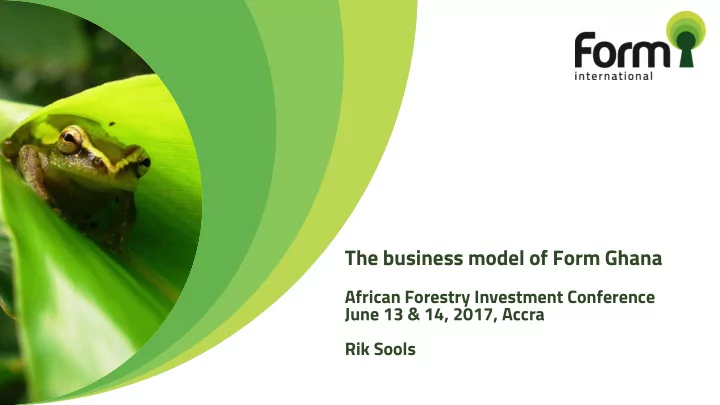

The business model of Form Ghana African Forestry Investment Conference June 13 & 14, 2017, Accra Rik Sools
Global view on forest plantations • World timber market volume • 1.5 billion m3 currently • 2-8 billion m3 expected by 2050 • Plantations provide 33% of global timber supply, 1.3% of forest cover • Currently 50 Million hectares industrial plantations • Need for additional 250-300 million hectares by 2050 (WWF) Indufor 2012 • Realistic expansion 40 Million hectares by 2050 (Indufor) • 600-700 billion USD invested in timberlands, mainly plantations
Harvestable volumes in plantation forests and natural forest (Sub)tropical forest plantations: • 200-700 m3/ha per rotation (7 to 30 years) Tropical natural forests: 5-30 • m3/ha (Africa, Latin America), 20- 60 m3/ha (SE-Asia) per rotation 25-30 years. Plantation forestry more intensive • and efficient way of production
So what’s the business case for forest plantations in the (sub)tropics? • Reasonable return rates possible, 8-15% • High tree growth rates • Low land and labour costs • Widely spread under-investment • Value-add of management • Human resources and technology improvements possible • Plantation timber demand increases • Timber supply from natural forest declines
Form Ghana Plantation Areas
Business plan main features Expand with 4,000 new hectares to 12,000 hectares planted forest • 90% teak, 10% indigenous & conservation • Revenu from teak sales, carbon credits and services • Long term land lease and benefit sharing with communities and • Forestry Commission FSC certification • ESG according to AFDB E&S requirements •
ECONOMIC Teak 90% - indigenous 10% • MAI – Main Annual Increment 14 m3/ha/yr • Final harvest at 20 years, commercial thinning 8 and 12 years • Total production 280 m3/ha • First FSC certified timber sales from Ghana 2016 • VCU carbon credits • 2,000 VCU sold, 3 million in the pipeline •
SOCIAL • Employment 1,000 staff: pension, social security, collective bargaining, skills development • Benefit sharing 10-20% Standing tree value • Intercropping : 90% of area, 1-2 years (400-500 farmers/year) • Awareness raising in region • Health & Safety • Relationship chiefs & communities • Outgrowing
ENVIRONMENTAL At least 10% native vegetation o Restocking native tee species (including o endangered species) Fire protection o Soil restoration: halt erosion, organic matter, o structure, moisture, Improve water quality and quantity o Protection and flora and fauna o Climate change mitigation: CO2 sequestration o Microclimate o
Planted area teak per age class Form Ghana plantations 2.000,0 1.789,8 1.800,0 1.600,0 1.406,2 Planted area (ha) 1.400,0 1.200,0 Teak plantations 1.000,0 813,2 Indigenous planted 800,0 695,5 605,2 581,6 Planted buffer 600,0 474,8 Remnant forest 400,0 129,9 200,0 128.0 53,1 0,0 2001 2008 2009 2010 2011 2012 2013 2014 2015 2016 Planting year • Total teak area: 6,670 hectares • Total area indigenous: 820 hectares (11%)
Timber flow Total harvested volume per quality class A B C Volume (m3) D 2014 2015 2016 2017 2018 2019 2020 2021 2022 2023 2024 2025 2026 2027 2028 2029 2030 2031 2032
Cash flow Cost and revenue development 2014-2035 Amounts US$'000) Timber revenues nominal Costs 2014 2015 2016 2017 2018 2019 2020 2021 2022 2023 2024 2025 2026 2027 2028 2029 2030 2031 2032 Year
Landscape restoration project • Build on PPP • Outgrowers timber • Climate smart agriculture • Collaborative fire management • Restoration and conservation • Inclusive finance • Smallholder organisation • Start up grant money • Business models around timber and agri-business
Success factors • Stepwise approach: pilot, get established, expand • Sound sustainable model – social and environmental (restore degraded land, social benefits) • Selection species, soil, climate (bankability) • Support local stakeholders • Robust financial model with strong revenue driver(s) • Strong investor(s) with long term commitment and blended finance • High biological growth • Management (track record, evidence, implementation capacity) • Entrepreneurship (business case, financing, marketing) • Enabling environment (PPP, land lease, benefit sharing, political and business climate) Challenges • Long investment period • Young sector in Africa, high risk perception (few projects, uncertain exit strategy, small industry) • Image plantations • Access to finance: Unknown to investors, patient capital scarce, climate finance??
Contact & info www.forminternational.nl www.formghana.com r.sools@forminternational.nl
Recommend
More recommend